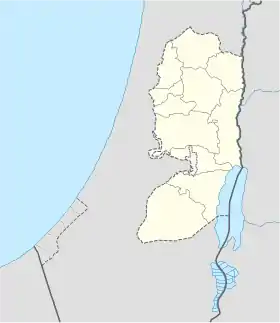Carmel (Israeli settlement)
Carmel (Hebrew: כרמל) is an Israeli settlement organized as a moshav in the south-east Mount Hebron (Har Hevron in Hebrew) area of the West Bank, close to the Palestinian Bedouin from the village of Umm al-Kheir, who settled there several decades ago after Israel expelled them from the Arad desert, and who purchased the land from residents in the Palestinian village of Yatta.[2] According to David Shulman, Carmel lies on lands appropriated from the Bedouin of that village.[3] It falls under the jurisdiction of the Har Hevron Regional Council and associates ideologically with the Amana settlement movement. In 2021 it had a population of 467.
Carmel
כרמל | |
|---|---|
 | |
 Carmel  Carmel | |
| Coordinates: 31°25′54″N 35°10′58″E | |
| District | Judea and Samaria Area |
| Council | Har Hevron |
| Region | West Bank |
| Affiliation | Amana |
| Founded | 1980 |
| Population (2021)[1] | 467 |
The international community considers Israeli settlements in the West Bank illegal under international law, but the Israeli government disputes this.[4]
Etymology
The name Carmel was chosen due to the moshav's close proximity to the location of biblical Carmel (Joshua 15:55).[5] Carmel is mentioned in 1 Samuel 25:2 as a place where Nabal of Maon had property.[2]
History
Initially founded in 1980, next to the land on which the Hadaleen Bedouin tribe live, as a Nahal military-establishment through a "military seizure order", the settlement was "civilianized" in 1981.[2]
Reuta Beth midrash was established in 2001[6] which is also a hesder yeshiva.
According to Nicholas Kristof of The New York Times, writing in an editorial in 2014 on what he called the "morally repugnant" nature of the Israeli occupation of the West Bank, contrasted the settlement of Carmel with the Palestinian village of Umm al-Kheir, writing that while the Palestinians are barred from connecting their home to the electric grid and live in tents and huts as the Israeli army demolishes any permanent structure they erect, Carmel is "a lovely green oasis that looks like an American suburb. It has lush gardens, kids riding bikes and air-conditioned homes. It also has a gleaming, electrified poultry barn that it runs as a business." Kristof quotes an Israeli human rights activist remarking on how the chickens in the poultry barn have more access to electricity than the Palestinian residents of Umm al-Kheir.[7]
Haaretz noted about this in 2011: "Right next to the stately country homes - complete with air-conditioning, drip-irrigation gardens and goldfish ponds - a few extended families including old men, old women and infants live in dwellings made of tin, cloth and plastic siding, though there are a few cinder-block structures, too. They tread on broken, barren ground. They have no running water. They are not connected to the power grid that lights up every settlement and outpost in this remote region. They have no access road."[2]
References
- "Regional Statistics". Israel Central Bureau of Statistics. Retrieved 22 February 2023.
- Ilana Hammerman, 'West Bank settlement is outdoing its neighboring Bedouin village,' Haaretz 11 November 2011
- David Shulman, Truth and Lies in South Hebron, Archived 2018-11-03 at the Wayback Machine Jewish Quarterly 18 June 2013. 'Um al-Khair, a ramshackle collection of tents and huts and simple stone houses and sheep-pens and corrugated shacks that borders, tragically, on the settlement of Carmel in the South Hebron Hills. Or rather, historically, Carmel borders on Um al-Khair, since the lands appropriated for the settlement in the early 80s all belonged to the Bedouin goat-herders and farmers who live on this rocky hill..'
- "The Geneva Convention". BBC News. 10 December 2009. Retrieved 27 November 2010.
- Carta's Official Guide to Israel and Complete Gazetteer to all Sites in the Holy Land. (3rd edition 1993) Jerusalem, Carta, p. 257, ISBN 965-220-186-3
- About Archived August 1, 2014, at the Wayback Machine Reuta
- Nicholas Kristof, 'The Two Sides of a Barbed-Wire Fence,', The New York Times 30 June 2010.